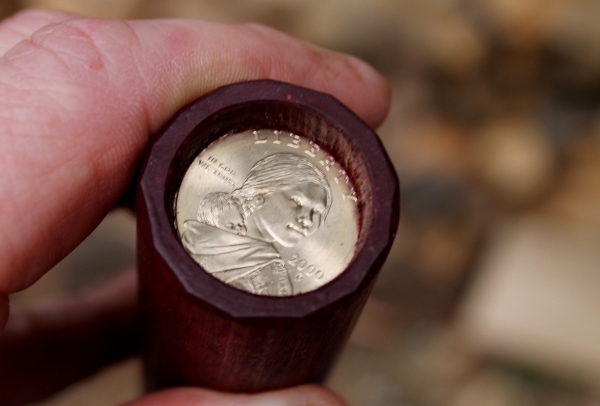
Sometimes you just have to get an odd idea out of your system. This one involved shrink pots, or more specifically, shrink tube bottoms. I’ve written several posts about shrink pots/boxes/tubes with procedures and all that. Here is a link to a list of those posts.
The whole idea of a shrink pot relies on the concept of a green dynamic ring of wood shrinking around a dry stable bottom. And shrink tube interiors are perfectly round, straight from the auger. The wheels started turning and I started measuring coins. Turns out, a U.S. dollar coin is 1.043 inches in diameter, perfect for popping into the bottom of a shrink tube drilled with a 1 inch auger. That exact measurement came from the U.S. Mint, here’s a link to their chart with all of the coin measurements.
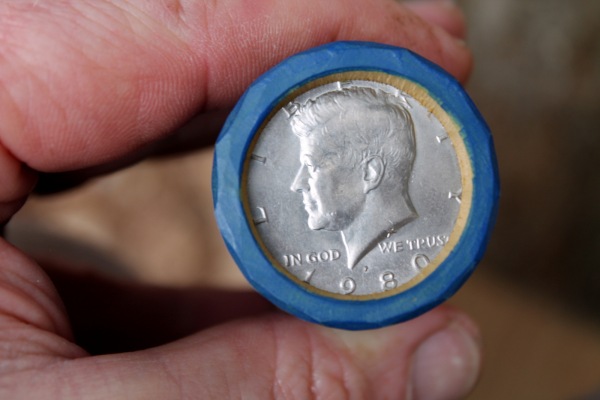
I noticed that a half-dollar coin is 1.205 inches and I have a 1 3/16 auger (1.19 inches)… so, now inspired by President Kennedy, I needed to figure out how to make the perfect groove to fit the coins. Both coins are very close to 2mm thick, so that was at least consistent.
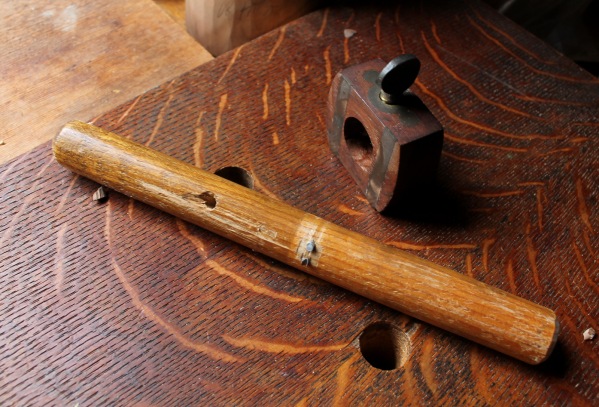
I cut off the end of an old broomstick which was about 7/8″ in diameter and took a gouge to the inside of an old yard sale marking gauge to go around it as a fence. There would be lots of ways to achieve the same idea.

I simply drilled two holes in line with each other across the width of the broomstick and inserted two wood screws until the threads were below the surface. Then I hacksawed the heads off, leaving just over 1/16″ rising above the surface of the wood. I filed them to the width of the coins (2mm), then made a groove in one with a triangular file. I refined the upper edges with a slipstone without reducing the width. The other nub was filed flat at the front and sides with an angle on top to form a bit of a chisel. Make sure the width of that second cutter is a bit narrower than the distance between the cutting spurs ahead of it. Ideally, I’ll file the sides of mine in a little more.

I put the back end of the broomstick in a vice, slipped the tube over the front end until it was up against the fence and rotated the tube to the right while pressing down on the cutters. The first cutter scores both sides of the groove and the second cutter clears the wood between. I used light cuts going around several times, clearing the wet wood bits from the cutters often. The result was a square groove that would fit over the edges of the coin. The screws aren’t heat treated tool steel or anything, but they’re still steel cutting green wood; worked fine for this light duty.
Update: I’ve added a sketch below that might make things more clear. It will all work much better if the sides of the raking cutter (the one on the right) are filed so that it is definitely narrower than the scoring cutter, as shown.
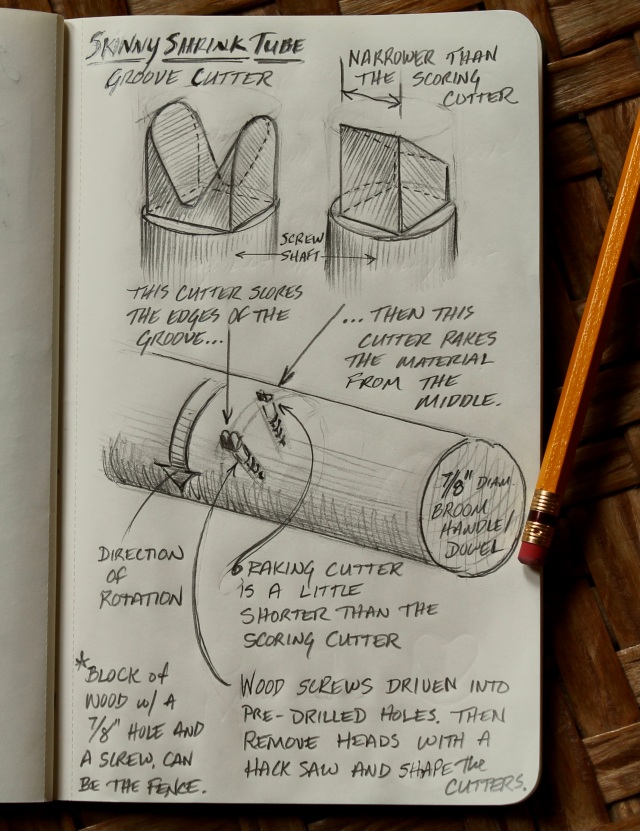
Anyway, Noah and I had fun working out the procedures that worked best together. We found that cutting a bit of a relief angle on the inner edge of the tube between the groove and the bottom edge of the tube allowed the coin to be funneled right down into the groove with a little pressure, then “pop,” it was in there. It could move side to side in the groove until a couple days later when all of the play was gone and the groove had squeezed over the edges of the coin permanently.
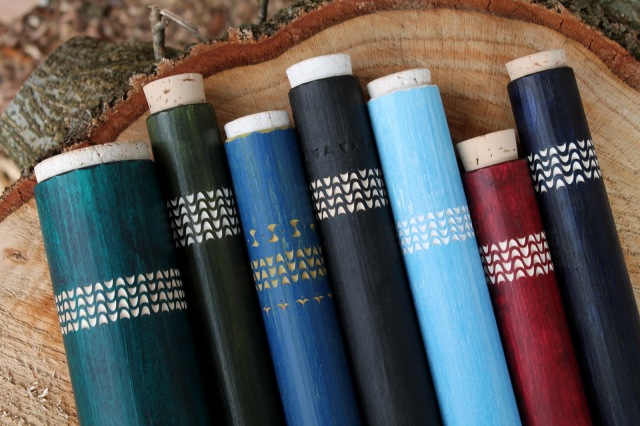
Noah and I painted them, then cut through the paint with a simple pattern of gouge chips. The wood beneath was light in color. Birch, cherry sapwood, and one aspen I think. We used thinned artist oil paint to create more of a glazed effect. On the third and fifth ones from the left, another different color after the carving. We tapered the interior of the top a bit with the tapered reamer and found some nice natural corks straight from the bark that seal the deal.

I like to use these things for pencil holders; the small ones hold about seven. The tubes are easy to pop into a pocket, a pack, or even a tool roll. They could also be handy for all sorts of things I suppose: tools, snacks, cigars? Regardless, they’re a blast to make and would be a fun project to do with kids as well. The possibilities for wood species and decoration are endless, and it’s a good use for straight small diameter pieces.

Above are three small ones in blue, red, and green. These are about 9 inches long.
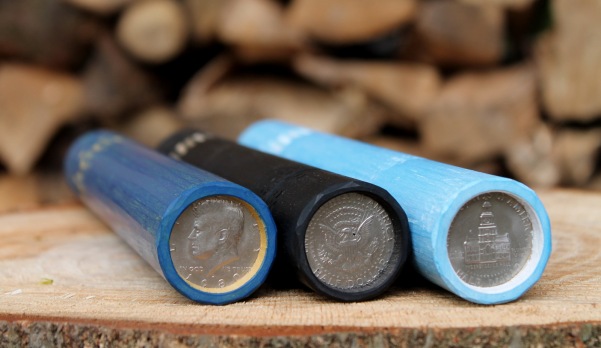
The half-dollar size are about 10 1/2″ long. Gold over blue, India ink, and white over blue.
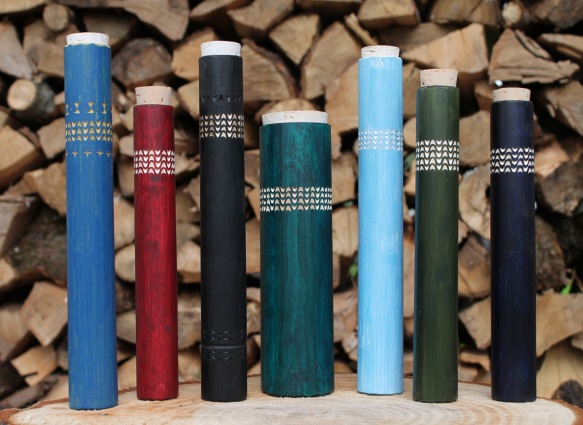
We also made a shrink tube with the 2″ T-handle auger, the one in the middle there. It’s 8 1/2″ long and has a wood bottom.
I hope you try making some of your own. Leave a question in the comments if I can help clarify the process for you. I see on the chart that a penny is 3/4″ and I’ll throw out the dime challenge. And how big is a two pence?

How on God’s green earth do you think of this stuff. Brilliant!
LikeLike
Just lack of focus!
LikeLike
This helps with something I’ve been thinking about a long time.
When I was a boy, Mr Will Henry Esco had a sweet gum walking stick with a natural crook handle.
At the end he had a
“Mercury ” dime in it. Freedom of thought rather than Mercury, but I digress. He told us all if we could get the dime out we could have it. We didn’t.
At some point I realized it must have been put in while the wood was green.
I’ve always thought of putting a coin in like Mr. Will Henry’s, but I usually wait until my sticks are dry to make them.
Guess my options are steaming the handles or cyanoacrylic glue. Think the glue would seem like cheating.
A tad off topic, but a connection with memories and goals for me.
Thanks!
LikeLike
Love that story, Jed. Looking forward to seeing a dime in one of your walking sticks sometime, however you decide to do it. It will be interesting to see if you can get some kids to work on getting that dime out the way Mr. Will Henry Esco did!
LikeLike
Brilliant!
LikeLiked by 1 person
Your creativity never ceases to amaze. And time well spent with Noah I’m sure will always be cherished.
LikeLike
He puts up with me, and It was a fun diversion for both of us from online teaching/schooling. Thanks Scott.
LikeLike
fun–
LikeLiked by 1 person
Heh. You realize that using metric and imperial/customary measures simultaneously immediately confers honourary Canadian citizenship?
LikeLiked by 1 person
Ha! Thanks, David! I will state your opinion on this matter to the guard the next time I’m crossing the border. Should speed things right along!
LikeLike
That croze is inspired!
LikeLike
That’s the word — croze! Just a tiny version of what coopers use.
LikeLike
Ohmygoodness I love these so much. Gives a whole new meaning to pencil/pen case. I love that Noah was in on them too!
LikeLike
Thanks, Amy! Noah said he prefers painting those over painting houses.
LikeLike
You are truly a wonder, Dave. I have a Kennedy half-dollar that belonged to my Grandfather…and this idea just made the list of answers for, “What am I going to do with this coin?”
LikeLiked by 1 person
Dave, could I make a match case with the coin on the lid?
LikeLike
Sure. You mean like two shrink tubes, one that fits over the other?
LikeLiked by 1 person
Very beautiful and clever.
I just need to ask, how do you keep the carving clean when painting on the second colour layer. Or if you fill in the carving stop the paint from spilling over the edge. Your edges always are so clean, I absolutely love it.
LikeLiked by 1 person
When I do two layers, I paint the first layer, then carve, then paint the second layer right over the first layer of paint and the freshly carved wood altogether. I typically take a paper towel and rub the second layer of paint from the surface to some extent. The second layer of paint effects the color of the first layer, especially if the first layer was put on very thin like a stain. So, for example, if I start with a thin coat of yellow, then carve a pattern through it, then go over everything with a thin coat of blue and wipe it back from the surface, the result will be a greenish surface with the carved bits blue and distinct borders. You can keep going like that and carve the surface again…
The carved sign on this post might be a good example. scroll down to the second photo:
https://davidffisherblog.wordpress.com/2019/08/18/spoonfest-2019/
I started by just painting the flat surface of the board a bright blue with thinned artist oil paint. Then once that was dry, I carved the tree trunk and branches. Then I went over everything, blue surface and tree, with white and rubbed the surface. The white softened the original bright blue to the color that you see but made the carved tree simply white. Once the white was dry, I carved the words and the leaves.
Really good question. I hope my explanation was clear enough.
LikeLike
Thanks for the explanation Dave, I don’t know if I ever encountered an explanation of yours that was not clear 😉
I will try to wipe off the second layer sometime.
Cheers
LikeLike
I had the same question and have had some success, though your work is more precise. Great question, great answer.
LikeLike
Lovely idea Dave. The design is so slick and clean lined.
I did a similar idea for a small set of picks I use at work. I rounded a split branch then bored down the center with a 3/4″ auger leaving the end intact. For a cap I used a short piece of the same branch and bored it out a little and cut the bored section with a knife to fit over the end the main piece.
I painted it with acrylic artists paints and oiled it.
It’s much better than the cracked old plastic case.
Your cork idea is a much better solution and looks stunning.
LikeLiked by 1 person
I like that idea, Neil. Working one side of the split branch allowed you to leave that end-grain bottom. Either way, like you said — better than plastic! I like that cap idea too. Thanks.
LikeLike
Hi Dave,
I love this idea. To answer your question, a two pence piece is 25.91mm or 1.02 inches in diameter. I would suggest using a pre-decimal penny, they are 30.8mm or 1.2 inches in diameter, about the same as your half dollar.
LikeLike
Thanks, Peter! And the two pence would work perfectly for the 1″ internal diameter. Bitcoins don’t stand a chance to catch on now!
LikeLike
Can you expand a bit on the wood you are using? I’m assuming it still needs to be in the round to ensure even-ish shrinkage? What kind of diameter are you starting with, and how are you ensuring you bore straight over what is quite a long length? I struggle to bore straight with a drill, let alone need to apply a turning force to the thing I’m trying to keep straight.
LikeLike
Yes, you have to use round wood, in other words you have to bore down the pith (center) of the length of branch or trunk. You can start with whatever diameter you have, but I’d leave yourself at least 1/2″ outside the hole you’re boring. If you make a 1″ shrink tube from a 6″ log, you’ll just have more wood to remove from the outside after boring the hole, and you still have to be reasonably accurate in boring along the center. You’ll be surprised how accurate you can be if you site down the length of the auger and the wood. I switch back and forth from looking from above and to the side. It helps if you can have a friend site along the side for you, telling you “up” or “down.” Nice thing about this is that wood for these is easy to come by and free, so if you mess up while boring a few, it’s no big deal and you’ll get more practice.
LikeLike
Pingback: Since You Gotta Brush Your Teeth Anyway | David Fisher, Carving Explorations